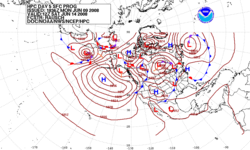
Back Weervoorspelling Afrikaans توقع جوي Arabic Hava proqnozu Azerbaijani Прагноз надвор’я Byelorussian Прагноз надвор’я BE-X-OLD Прогноза за времето Bulgarian Predicció meteorològica Catalan Předpověď počasí Czech Vejrudsigt Danish Wettervorhersage German

| Part of a series on |
| Weather |
|---|
|
|
Weather forecasting is the application of science and technology to predict the conditions of the atmosphere for a given location and time. People have attempted to predict the weather informally for millennia and formally since the 19th century.
Weather forecasts are made by collecting quantitative data about the current state of the atmosphere, land, and ocean and using meteorology to project how the atmosphere will change at a given place. Once calculated manually based mainly upon changes in barometric pressure, current weather conditions, and sky conditions or cloud cover, weather forecasting now relies on computer-based models that take many atmospheric factors into account.[1] Human input is still required to pick the best possible model to base the forecast upon, which involves pattern recognition skills, teleconnections, knowledge of model performance, and knowledge of model biases.
The inaccuracy of forecasting is due to the chaotic nature of the atmosphere; the massive computational power required to solve the equations that describe the atmosphere, the land, and the ocean; the error involved in measuring the initial conditions; and an incomplete understanding of atmospheric and related processes. Hence, forecasts become less accurate as the difference between the current time and the time for which the forecast is being made (the range of the forecast) increases. The use of ensembles and model consensus helps narrow the error and provide confidence in the forecast.
There is a vast variety of end uses for weather forecasts. Weather warnings are important because they are used to protect lives and property. Forecasts based on temperature and precipitation are important to agriculture, and therefore to traders within commodity markets. Temperature forecasts are used by utility companies to estimate demand over coming days. On an everyday basis, many people use weather forecasts to determine what to wear on a given day. Since outdoor activities are severely curtailed by heavy rain, snow and wind chill, forecasts can be used to plan activities around these events, and to plan ahead and survive them.
Weather forecasting is a part of the economy. For example, in 2009, the US spent approximately $5.8 billion on it, producing benefits estimated at six times as much.[2]
- ^ Dirmeyer, Paul A.; Schlosser, C. Adam; Brubaker, Kaye L. (February 1, 2009). "Precipitation, Recycling, and Land Memory: An Integrated Analysis" (PDF). Journal of Hydrometeorology. 10 (1): 278–288. Bibcode:2009JHyMe..10..278D. doi:10.1175/2008JHM1016.1. hdl:1721.1/52326. S2CID 14539938.
- ^ Fostering Innovation, Creating Jobs, Driving Better Decisions: The Value of Government Data. Economics and Statistics Administration Office of the Chief Economist. July 2014. p. 15. Archived from the original on August 29, 2018. Retrieved December 30, 2018.